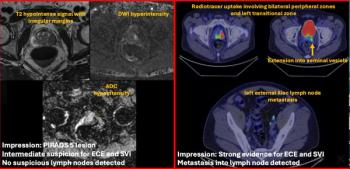
Greek multicast network improves interventional teleradiology
Few existing teleradiology systems are able to support the collaboration demands of remote interventional radiology procedures. Most suffer from limited bandwidth, end-to-end delay, and problems with clinically acceptable image quality.
Few existing teleradiology systems are able to support the collaboration demands of remote interventional radiology procedures. Most suffer from limited bandwidth, end-to-end delay, and problems with clinically acceptable image quality.Researchers in Greece have proposed a solution in the form of a multicast hybrid satellite system that enables more effective interventional teleradiology collaboration."We developed a system that addresses previous challenges by multicasting required wavelet-based video feeds," said Lefteris G. Gortzis, Ph.D., of the medical physics department at the University of Patras. The system uses interactive features within a common multiscreen interface.Recent testing demonstrated the feasibility of the system. Eight interventional radiologists and a vascular surgeon participated via satellite link in several fully collaborative, complex interventional radiology procedures with an average duration of 90 minutes.The key characteristic of the new system is that it effectively addresses current remote inefficiencies by multicasting the required wavelet-based data."The system supports remote interventional collaboration through the employment of a hybrid satellite-terrestrial network, a prototype multicast version of a wavelet-based interactive communication application called WinVicos, and a partition aggregation and conditional coding (PACC) wavelet codec," Gortzis said.The proposed system appears to achieve its favorable effect on synchronous collaboration during advanced interventional radiology procedures over a teleradiology network by improving intervention technique planning and reducing radiation exposure risk. It also is effective at handling necessary heavy data traffic loads, including catheterization lab visual reconstruction and online availability of previous studies, he said.The Greek system is composed of four dispersed collaborative nodes located at three sites: two nodes at the University Hospital of Patras, one node at Charité Hospital in Berlin, and one intermediate node at the National Centre for Scientific Research in Athens. The system employs a common multiscreen interface and multicasts at least five video feeds simultaneously, Gortzis said.
The video feeds are presented in popup windows displaying:
- the angio unit output signal, which is captured to support the visual reconstruction of the intervention area
- the cath lab ceiling camera output signal, which captures hand movements of the interventionalist performing the procedure
- the document camera output signal, which is captured to visualize MRI or MR cholangiopancreatography
- the collaborators' camera output signals, which are captured separately to support conference capabilities
Newsletter
Stay at the forefront of radiology with the Diagnostic Imaging newsletter, delivering the latest news, clinical insights, and imaging advancements for today’s radiologists.




























